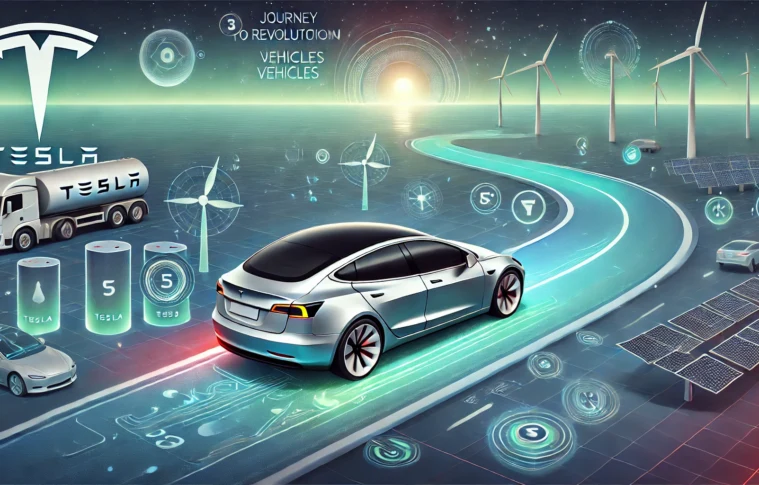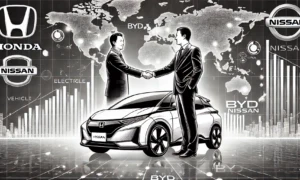On Tesla, Inc. has become a symbol of innovation, disruption, and the future of transportation. Founded in 2003 by Martin Eberhard and Marc Tarpenning, and later led by Elon Musk, Tesla revolutionized the electric vehicle (EV) market with a blend of cutting-edge technology, bold market strategies, and relentless ambition. From its early days as a niche electric sports car company to its position as the world’s leading EV manufacturer, Tesla’s journey offers critical lessons in innovation, scaling, and overcoming industry challenges.
1. Innovation at the Core: Pioneering Electric Vehicles
At the heart of Tesla’s rise is its focus on innovation, both in terms of vehicle technology and manufacturing processes.
Electric Powertrain and Battery Technology
- Battery Development: One of Tesla’s key differentiators has been its focus on developing high-performance batteries. The company partnered with Panasonic to develop its proprietary battery cells, ensuring that its cars had the range, power, and performance to rival traditional internal combustion engine vehicles.
- Supercharger Network: Tesla built its own network of Superchargers to enable long-distance travel, something that was previously a major limitation for electric vehicles. This move not only made Tesla cars more practical but also positioned the company as a leader in EV infrastructure.
- Autonomous Driving Technology: Tesla has pushed the envelope in autonomous driving, with its Autopilot feature offering semi-autonomous driving capabilities. Tesla’s aggressive approach to developing self-driving software continues to be a key part of its vision for the future of transportation.
2. Market Strategies: Disrupting the Automotive Industry
Tesla’s market strategies have been equally innovative, enabling the company to grow rapidly while defying traditional industry expectations.
Direct Sales Model
- Unlike most car manufacturers, Tesla chose to sell vehicles directly to consumers through its own network of retail stores and its online platform, bypassing traditional dealerships. This direct sales model allowed Tesla to control the customer experience, maintain higher profit margins, and provide better customer service.
- Impact of Consumer Loyalty: Tesla built a loyal customer base that serves as its most valuable marketing asset. Word-of-mouth from satisfied owners, along with a strong online community, allowed Tesla to expand its reach without spending billions on traditional advertising.
High-End Electric Sports Car to Mainstream Vehicles
- The Roadster (2008): Tesla’s first vehicle, the Roadster, was a high-end electric sports car that proved electric vehicles could be fast, stylish, and sustainable. It established Tesla as a pioneer in the EV market, despite being a niche product aimed at affluent early adopters.
- The Model S (2012): The launch of the Model S marked a major leap toward making EVs more mainstream. It received critical acclaim for its performance, design, and range, cementing Tesla’s position as a serious player in the automotive industry.
- Affordable Models (Model 3 & Model Y): With the introduction of the Model 3 in 2017 and the Model Y in 2020, Tesla targeted the mass market. These more affordable electric vehicles allowed Tesla to scale up production and expand its consumer base significantly. The Model 3, in particular, became the best-selling EV globally, achieving significant success in North America, Europe, and Asia.
Global Expansion and Gigafactories
- Gigafactories: To meet growing demand, Tesla invested heavily in building Gigafactories, massive production plants dedicated to both vehicle manufacturing and battery production. Tesla’s Gigafactory in Nevada is one of the world’s largest factories and a key component in Tesla’s mission to drive down battery costs.
- International Markets: Tesla’s global expansion strategy also saw the opening of production facilities in Shanghai, Berlin, and Austin, allowing the company to meet the demand for EVs in regions like China and Europe.
3. Challenges in Scaling EV Production
Despite its success, Tesla has faced numerous challenges in scaling its electric vehicle production and maintaining profitability.
Supply Chain and Manufacturing Challenges
- Battery Supply and Raw Materials: One of the biggest challenges for Tesla has been securing the necessary supply of batteries and raw materials like lithium, cobalt, and nickel. Fluctuating material prices and supply chain bottlenecks have at times slowed production and caused financial strain.
- Scaling Production: Early on, Elon Musk famously referred to Tesla’s production challenges as “production hell.” Scaling production to meet demand for mass-market models like the Model 3 has proven to be an ongoing struggle. Tesla has had to invest heavily in automation and new manufacturing processes to overcome production delays.
- Global Supply Chain Issues: The COVID-19 pandemic, semiconductor shortages, and supply chain disruptions have all impacted Tesla’s production and delivery timelines, leading to delays and price increases.
Quality Control and Consistency
- As production ramped up, Tesla also faced criticism over the quality control of its vehicles. Issues such as inconsistent panel gaps, paint defects, and delivery delays were widely reported, particularly with the Model 3. These concerns raised questions about whether Tesla’s rapid growth was coming at the expense of vehicle quality.
- Despite these challenges, Tesla continued to refine its production processes and introduced software updates to address issues remotely, showing its commitment to continuous improvement.
Competition in the EV Market
- As Tesla leads the EV market, it faces increasing competition from established automakers like General Motors, Ford, Volkswagen, and newer players like Rivian and Lucid Motors. These competitors are rapidly increasing their investments in EV development, threatening Tesla’s dominance in the electric vehicle space.
- Price Cuts and Model Diversity: To maintain its competitive edge, Tesla has been forced to cut prices on several of its models, while also expanding its vehicle lineup to include more affordable and diverse options. This price strategy, while effective in boosting sales, has put pressure on Tesla’s margins and profitability.
4. The Road Ahead: Tesla’s Future
Tesla continues to innovate and push the boundaries of what is possible in the automotive and energy sectors. The company’s focus remains on increasing vehicle production, improving battery technology, and leading the way in autonomous driving.
- Battery Innovation: Tesla continues to work on its battery technology to improve energy density, reduce costs, and make EVs more affordable and efficient. The development of the “4680” battery cells is a critical part of Tesla’s long-term strategy.
- Full Autonomy and AI: Tesla’s ambition for fully autonomous driving remains a key area of focus. Tesla continues to improve its Full Self-Driving (FSD) software, although regulatory hurdles and technological challenges persist.
- Sustainable Energy Integration: Tesla’s vision extends beyond vehicles to include solar energy products and energy storage solutions. Tesla’s acquisition of SolarCity and the expansion of its Powerwall product line are part of its broader strategy to create an integrated, sustainable energy ecosystem.
Conclusion: Tesla’s Impact on the EV Market
Tesla’s journey from a niche startup to the world’s leading electric vehicle manufacturer is a testament to the power of innovation, bold market strategies, and a commitment to sustainability. Despite facing significant challenges in scaling production and maintaining profitability, Tesla has reshaped the global automotive industry and accelerated the shift toward electric vehicles. As Tesla continues to innovate and expand, its impact on the future of transportation and energy will undoubtedly be profound.



